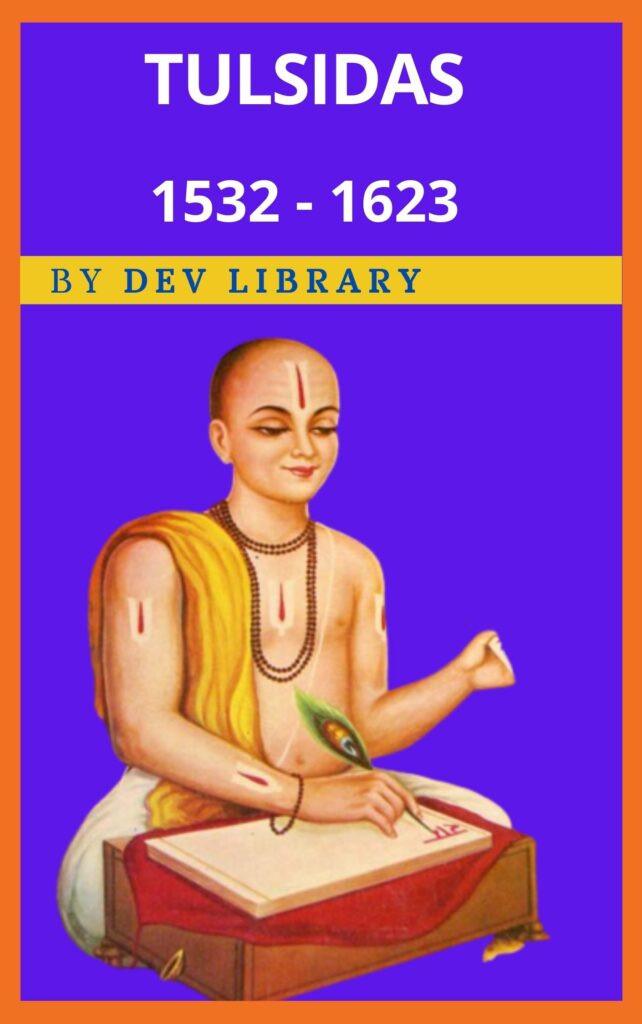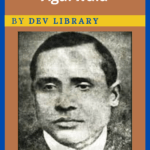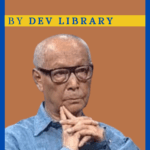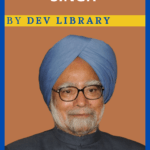Tulsidas was a great Indian poet and philosopher. Tulsidasji is the creator of ‘Ramacharitmanas’, one of the greatest epics ever written. Tulsidasji’s full name was Goswami Tulsidas and he was born in 1532 AD during the reign of Mughal Emperor Akbar in Rajapur district of Bandar in Uttar Pradesh, India.
Tulsidas was by birth a Sanadhya Brahmin and is considered to be the incarnation of Valmiki Rishi, who composed the Ramayana in Sanskrit. Tulsidas was the son of Atmaram Dubey and Hulsi. However, Tulsidas’ childhood was spent in poverty and misery. He was a true follower of Lord Ram and studied from his guru Narharidas.

Biography of Tulsidas
| Name | Goswami Tulsidas[1] |
| Date of Birth | 1532 |
| Place of Birth | Rajapur, Banda, Uttar Pradesh |
| Mother’s Name | Hulsi Devi |
| Father’s Name | Atmaram Dubey |
| Education | Vedas, Puranas and Upanishads were taught from a young age |
| Wife’s Name | Ratnavali |
| Children Name | Taraka (Son) |
| Religion | Hinduism |
| Death | 31 July 1623 |
Early Life of Tulsidas
Tulsidas was born on Saptami, the seventh day of Shukala Paksha, the bright half of the lunar Hindu calendar month Shraavana on1532. There is a lot of difference of opinion about his birthplace, but according to most scholars, he was born in Rajapur in Chitrakoot district of Uttar Pradesh.
Tulsidas’ childhood name was Rambola and his father’s name was Atmaram Dubey and his mother’s name was Hulsi. Tulsidas’s guru’s name was Nara Haridas. Often people stay in their mother’s womb for 9 months, but Tulsidasji is in his mother’s womb for 12 months and when he was born, he had all thirty two teeth in his mouth, his health and looks were like that of a five year old boy, and he did not cry at the time of his birth and he uttered Ram as soon as he was born, which led to his name Rambola in his childhood. Due to the inauspicious events at the time of his birth, he was abandoned by his parents and relatives. His mother died the day after his birth. His father handed him over to a maid named Chuniya, a female servant of Hulsi.
According to astrologers he was born at an ominous time and hence his parents left him as a young child. His mother’s servant Chuniya took him with her and raised him for five and a half years and then she died. Rambola was left to fend for himself as an impoverished orphan, and wandered from door to door begging for alms. It is believed that the goddess Parvati assumed the form of a Brahmin woman and fed Rambola every day.
After being left alone, at the age of six Narharidas, the Vaishnava ascetic of Ramananda’s monastic order, adopted Rambola, who named him Tulsidas. Narharidas described to the young boy ‘Ramayana’ several times and a while ago Tulsidas became an enthusiastic devotee and follower of Ram. Tulsidas narrates the dialogue that took place during the first meeting with his guru in a passage in the Vinayapatrika.
He then went to Varanasi where he studied Sanskrit grammar, four Vedas, six Vedangas, Jyotisha and six schools of Hindu philosophy from guru Shesha Sanatana, a renowned scholar of literature and philosophy, who was based at the Pancaganga Ghat in Varanasi. Shesha Sanatana was a friend of Narharidas. His studies continued for 15-16 years and he then returned to Rajapur.
Also Read : Biography of Kalidas
Education of Tulsidas
Rambola (Tulsidas) was given the Virakta Diksha( Vairagi initiation) and got the new name Tulsidas. When he was seven years old his Upanayana was performed by Narharidas on the fifth day of the bright half of the month of Magha(January – February) at Ayodhya, a pilgrimage site related to Rama. He started his first education in Ayodhya. He mentioned in his epic “Ramcharitmanas” that his guru had repeatedly described Ramayana to him. He came to the holy city of Varanasi when he was just 15-16 years old, where he studied Sanskrit grammar, Hindu literature and philosophy, four Vedas, six Vedangas, and he acquired the knowledge of astrology.
After studying, he returned to his native Chitrakuta with the permission of his guru. He started living in his family home and started narrating the story of “Ramayana.”
Marriage Life of Tulsidas
Fifteen years after Sheshaji’s death, he returned to his native Rajapur. Returning he started telling people about Ram. The fame of his story began to spread rapidly. When a Brahmin above the Yamuna heard his fame, he married his daughter Ratnavali to Tulsidas.
Tulsidas was in deep love with his wife. Once when Tulsidas had gone to a Hanuman temple, Ratnavali went to her father’s house with her brother. When Tulsidas came to know this, he swam across the Yamuna river in the night to meet his wife. He could not disconnect with his wife and reached his in-law’s house to meet his wife in the middle of the night.
His wife was very angry with his actions and chided Tulsidas for this, and remarked that ‘There is no point in loving this leather body,’. If Tulsidas was even half as devoted to God as he was to her body of flesh and blood, he would have been redeemed. Tulsidas was disillusioned to hear these words from his wife. He left her instantly and left for the holy city of Prayag. And after reaching, he immediately became a Hindu Sadhu (monk).
Literary Life of Tulsidas
Tulsidas started composing poems in Sanskrit for the people of Varanasi on the Prahlada Ghat. Traditions holds that all the versed that he composed during the day, would get lost in the night. This happened daily for eight night. On the eight night, shiva whose famous Kashi Vishwanath Temple is located in Varanasi is believed to have ordered Tulsidas in his dream to compose his poems in the vernacular instead of Sanskrit. Tulsidas opened his eyes and saw that both Shiva and Parvati blessed him. Shiva ordered Tulsidas to go to Ayodhya and compose his poems in Awadhi. Shiva also predicted that Tulsidas’ poetry would fructify like the Sama Veda. In Ramacharitmanas, Tulsidas hints at having the Darshan of Shiva and Parvati in both dream and awakened state.
Tulsidas’s composition and Travel
Tulsidas decided to travel and he went to Jagannathpuri, Rameshwaram, Dwarka and Badrinath. From there he travelled to Kailash and Manasarovar lake. He continued his journey continuously for nearly 17 years and eventually settled in Chitrakuta. In the year Vikram 1631, he started composing Ramcharitmanas in Ayodhya on Sunday and it took him 2 years and 7 months and twenty-six days to complete it and completed the work in Vikram 1633 on the Vivaha Panchami day. Very few people would know that influenced by Surdas, Goswamiji also composed Gitavali and Krishna Gitavali, both of which he composed before Ramcharitmanas.
Tulsidasji started writing his writings from 1574, and wrote many literature, although his best work is the epic ‘Ramsaritamanas’ (description of Ram’s work), it contains beautiful poems written under the name ‘Chaupai’, these poems are dedicated only to Lord Ram. Tulsidasji dedicated himself to God and focused on the path of salvation. Some of the other great literary works written by Tulsidas include Dohawali, Kavitawali, Gitavali, Krishnawali, Vinoypatrika and Hanuman Chalicha is a much respected poem praised by God Hanuman. His short works include Barvai Ramayana, Janaki Mangal, Ramlala Nahachhu, Parvati Mangal and Sankat Moochan.
Goswami Tulsidas’s works were appreciated by Mughal rulers Akbar and Jahangir. Tulsidasji went to the holy city of Banaras. Even today Tulsidas’s writings show the integration of his deep devotion and philosophical ideology, becoming one of the greatest Hindi poets to have written such excellent literature.
Contribution of Tulsidas
Goswami Tulsidasji’s biggest contribution is considered to be Ramcharitmanas through which he made Ram attractive to the people. Through this book he not only conveys the message of devotion but also the message of social reform.
He also served Indian literature a lot, Hindi poetry was recognized all over the world. He composed his compositions in all genres of poetry. His language ornaments were unique. He also wrote on Sanskrit by authority.
Death and the last composition of Tulsidas
Tulsidas had been ill for many years and died at the age of 91on 31 July 1623 in Shravan month of the year Vikram in 1680 in Assi Ghat on the bank of the river Ganga. He last recalled Ram’s name at Assi Ghat on the banks of river Ganga, while Tulsidas is said to have written the last composition Vinaypatrika before his death which was signed by Lord Ram himself. The Vinaypatrika is considered as the last composition of Tulsidas, believed to be written when Kali Yuga started troubling him. In this work of 2798 stanzas, he beseeched Rama to give him Bhakti(“devotion”), and to accept his petition. He attests in the last stanza of Vinaypatrika that Rama himself signed the manuscript of the work. The 45th stanza of the Vinaypatrika is sung as the evening Aarti by many Hindus.
FAQ
1. What is Tulsidas’s caste ?
Ans: Tulsidas was a Brahmin from birth and was believed to be the reincarnation of the sanskrit Ramayana, the author of Valmiki.
2. Did Akbar meet Tulsidas?
Ans: “Emperor Akbar and Saint Tulsidas met at the Lakha Mela in Kasi. Emperor Akbar also got to watch the exhibition of Nag Natya in the religious city of Kasi. The emperor’s main aim here was to attend the festival and enjoy the privilege of meeting Goswami Tulsidas.
3. Was Tulsidas born with teeth?
Ans: According to legend Tulsidas was born after twelve months in the womb, during his birth he had thirty-two teeth in his mouth, His health and appearance were like a five-year-old boy, and he did not cry at birth but instead uttered Ram.
4. How did Tulsidasji died?
Ans: Tulsidasji suffered from ill health in his later years and died in 31 July 1623.
5. What was Tulsidas’ wife’s name?
Ans: Tulsidas’ wife’s name is Ratnavali.
6. Who wrote Ramcharitmanas?
Ans: Goswami Tulsidas.
7. Who wrote the Hanuman Chalisa?
Ans: Tulsidas.

Hi, I’m Dev Kirtonia, Founder & CEO of Dev Library. A website that provides all SCERT, NCERT 3 to 12, and BA, B.com, B.Sc, and Computer Science with Post Graduate Notes & Suggestions, Novel, eBooks, Biography, Quotes, Study Materials, and more.








